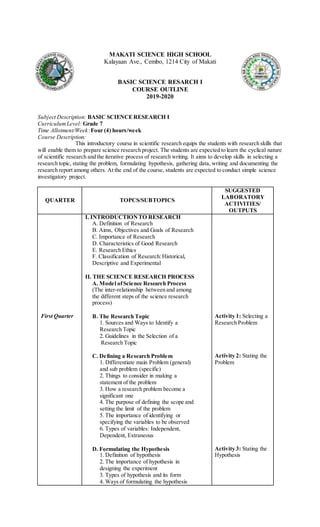
BSR I Course Outline 2019-2020
- 1. MAKATI SCIENCE HIGH SCHOOL Kalayaan Ave., Cembo, 1214 City of Makati BASIC SCIENCE RESARCH I COURSE OUTLINE 2019-2020 Subject Description: BASIC SCIENCERESEARCH I CurriculumLevel: Grade 7 Time Allotment/Week:Four (4) hours/week Course Description: This introductory course in scientific research equips the students with research skills that will enable them to prepare science research project. The students are expected to learn the cyclical nature of scientific research and the iterative process of research writing. It aims to develop skills in selecting a research topic, stating the problem, formulating hypothesis, gathering data, writing and documenting the research report among others. At the end of the course, students are expected to conduct simple science investigatory project. QUARTER TOPCS/SUBTOPICS SUGGESTED LABORATORY ACTIVITIES/ OUTPUTS First Quarter I. INTRODUCTIONTO RESEARCH A. Definition of Research B. Aims, Objectives and Goals of Research C. Importance of Research D. Characteristics of Good Research E. Research Ethics F. Classification of Research:Historical, Descriptive and Experimental II. THE SCIENCE RESEARCH PROCESS A. Model ofScience Research Process (The inter-relationship between and among the different steps of the science research process) B. The Research Topic 1. Sources and Ways to Identify a Research Topic 2. Guidelines in the Selection of a Research Topic C. Defining a Research Problem 1. Differentiate main Problem (general) and sub problem (specific) 2. Things to consider in making a statement of the problem 3. How a research problem become a significant one 4. The purpose of defining the scope and setting the limit of the problem 5. The importance of identifying or specifying the variables to be observed 6. Types of variables: Independent, Dependent, Extraneous D. Formulating the Hypothesis 1. Definition of hypothesis 2. The importance of hypothesis in designing the experiment 3. Types of hypothesis and its form 4. Ways of formulating the hypothesis Activity 1: Selecting a Research Problem Activity 2: Stating the Problem Activity 3: Stating the Hypothesis
- 2. Second Quarter E. Planning the Research Design 1. Two phases in planning the research design 1.1 Theoretical Phase 1.2 Actual Experiment Phase 2. Types of Research Design 2.1 One Group, Two Group and Parallel Group 2.2 Completely Randomized Design (CDR) 2.3 Complete Block Design F. The Time Table and Its Importance How to make a Gantt Chart G. Materials and Methods Rules to follow in writing the Materials and Methods 1. Research Proposal(Before) 2. Technical Report (After) H. Establishing Patterns ofTrends in the data collected 1. Continuous Data vs Discrete Data 2. Qualitative Data Vs Quantitative Data 3. Nominal Data vs Ordinal Data 4. Interval Data vs Ratio Data I. Tabulating and Graphing the Data 1. Forms of Graphs: Bar,Line, Pie Graphs 2. Types of graph suited to the type of data J. Describing the Data 1. Ways of describing a set of numerical data 2. Measure of Variation K. Interpreting Qualitative and Quantitative Data Activity 4: Research Design Activity 5: Classifying Data Activity 6: Making Data,Tables and Graphs Activity 7: Identifying Measures of Central Tendency Third Quarter L. Testing Hypothesis 1. Descriptive vs. Inferential Statistics 2. Population vs Sample 3. Appropriate Statistical Test 3.1 T-Test,Z-Test, F-Test 3.2 Chi-Square 3.3 ANOVA 3.4 Correlation Coefficient M. Making Conclusions and Recommendations Guidelines for making Conclusion and Recommendation N. Writing the Abstract O. Format of Project Write-Up (Intel Philippines Science Fair) Activity 8: Identifying Statistics Activity 9: Research Design Activity 10: Working with Research Data Activity 11: Writing Conclusion and Recommendation Activity 12: Writing Abstract Quarter Output: SIP III. PRESENTATIONOF A SIMPLE INVESTIGATORYPROJECT A. Presenting your SIP
- 3. Fourth Quarter B. Preparing a Visual Display C. Giving Oral Presentation D. Writing a Scientific Article IV. EVALUATION OF RESEARCH OUTPUT A. Discussion on Proofreading Symbols B. Checklist for Evaluating a Research Paper C. Reading and Evaluation of Environmental Science Research Article D. Writing of Environmental Science Research Article Review Quarter Output: Scientific Research Article Review Marian Grace C. Toribio Teacher
